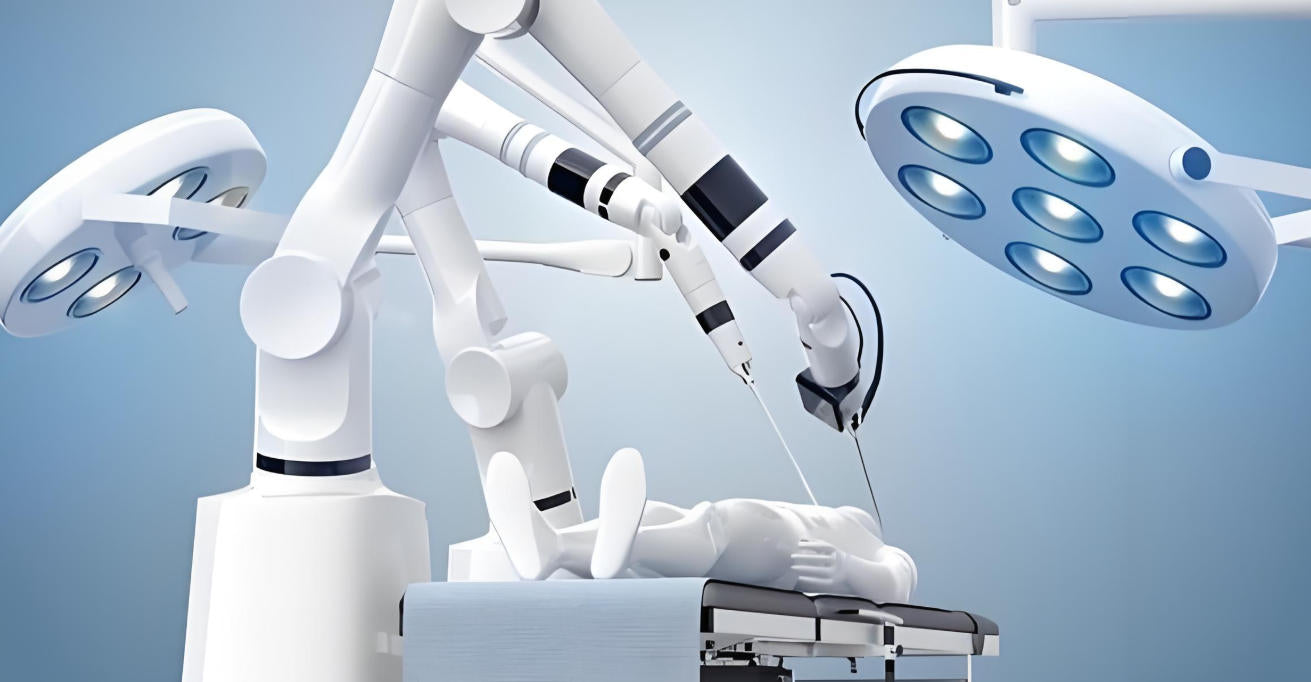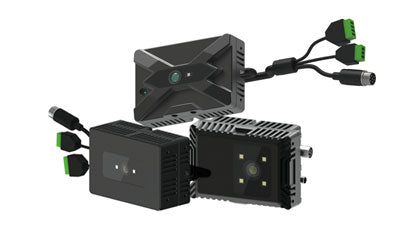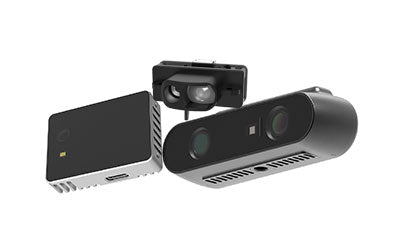TOF in Surgical Robots : Enhancing Precision Navigation & Support

How do surgical robots utilize TOF technology to achieve precise navigation and safe operations?
With the rapid advancement of medical technology, surgical robots are playing an increasingly important role in minimally invasive surgery, complex procedures, and remote medicine. However, for surgical robots to truly achieve precision, safety, and intelligence, the key lies in 3D perception and precise navigation. TOF (Time-of-Flight) (https://en.wikipedia.org) technology, as a next-generation 3D imaging solution, provides surgical robots with higher-dimensional vision, thereby improving surgical accuracy and operational safety.
What is TOF (Time-of-Flight) Technology?
TOF is a sensing method that measures distance and acquires 3D information based on the propagation time of light pulses. The basic principle is: the sensor emits a beam of light (usually infrared or laser), which reflects off an object and returns to the sensor. By calculating the round-trip travel time of the light, the distance between the object and the sensor can be determined.
In application, TOF technology can generate high-precision depth maps and 3D spatial models, and is widely used in:
-
Smartphones: facial recognition, virtual beautification, AR measuring tools.
-
Smart TVs and entertainment devices: gesture recognition, motion sensing, multiplayer interactive games.
-
Wearable devices: respiration monitoring, posture recognition, sleep detection, and health management.
-
Surgical robots and healthcare: 3D navigation, precise operations, and real-time tracking.
-
Autonomous driving and robotics: obstacle detection, path planning, and environmental mapping.
In summary, TOF is a 3D perception technology that obtains depth information by measuring the 'flight time of light.' Its advantages—fast speed, non-contact measurement, and adaptability—make it widely applicable in consumer electronics, healthcare, automotive, and industrial fields.

1. The Demand for 3D Perception in Surgical Robots
In traditional surgery, doctors primarily rely on visual observation and 2D imaging (such as endoscopy, CT, or X-rays). However, in complex surgical environments, 2D vision has clear limitations. Especially in Minimally Invasive Surgery (MIS), where the surgical channel is narrow and the visible field restricted, surgeons must perform highly precise dissections and sutures within a limited view—posing immense demands on spatial perception and hand-eye coordination.
Limitations of traditional vision systems:
They only provide flat images, making it difficult to accurately reflect depth relations between instruments and tissues. Even with stereo vision systems, errors can occur due to poor lighting, reflective tissue, or obstruction by bodily fluids. As a result:
-
Spatial judgment errors: surgeons may struggle to precisely determine the relative position of instruments and tissues.
-
Risks to critical structures: operations involving blood vessels or nerves carry high risks if millimeter-level errors occur.
-
Increased cognitive load: surgeons must constantly compensate for visual inaccuracies through experience, leading to greater fatigue and stress.
Thus, surgical robots urgently require a solution that enables real-time depth perception and 3D reconstruction.
This is where TOF 3D imaging proves advantageous. With TOF sensors, surgical robots can:
-
Build real-time 3D models: accurately capture the spatial location and depth of instruments and tissues.
-
Enhance operative precision: reduce errors caused by 2D vision, achieving millimeter or even sub-millimeter accuracy.
-
Enable automation: provide data for intelligent, semi-automated, or even fully automated robotic procedures.
-
Ensure surgical safety: significantly lower risks when operating in high-stakes anatomical areas.
In essence, TOF 3D imaging is not just a supplement to 2D vision, but a core driver pushing surgical robots toward higher precision, intelligence, and safety. With the integration of AI, future surgical robots may achieve a closed-loop system of real-time perception + intelligent decision-making + precise operation, revolutionizing surgical standards and practices.
2. TOF for Precision 3D Navigation
TOF technology works by emitting light pulses and measuring their return time, thereby quickly and accurately acquiring depth data and generating 3D point cloud models. In medical robotics, this breakthrough in depth sensing provides unprecedented visualization and operational support.
Compared to traditional 2D imaging, TOF offers several advantages:
-
Real-time 3D imaging
TOF sensors can capture depth information in milliseconds, enabling dynamic 3D reconstruction. Even in complex intraoperative environments, surgical robots can clearly perceive tissue boundaries and spatial relationships, providing surgeons with an intuitive surgical view. -
Precise surgical navigation
Using TOF 3D data, surgical robots can match instrument positions with patient anatomy with high accuracy, avoiding damage to critical blood vessels or nerves. This 3D navigation capability reduces intraoperative risks and enhances safety. -
Dynamic tracking
Human organs constantly move due to respiration, heartbeat, and blood flow. TOF enables real-time tracking of these changes, allowing robots to automatically adjust their path during cutting, suturing, or ablation to maintain precision. -
Surgical planning assistance
TOF-generated 3D models enable surgeons to create better preoperative plans and make intraoperative adjustments based on real-time data. This 'operate and plan simultaneously' ability improves both efficiency and flexibility.
Together, these capabilities transform surgical robots from mere mechanical tools into intelligent surgical assistants. By combining depth perception, real-time navigation, and dynamic tracking, TOF-powered robots deliver higher success rates and better patient outcomes, and may soon become a standard feature in modern surgery.

3. Practical Applications and Clinical Cases
TOF technology is moving from laboratory research into clinical practice, showing strong potential across multiple surgical domains.
-
Minimally invasive surgery: Precision under 3D vision
In laparoscopic or arthroscopic procedures, surgeons traditionally depend on 2D imaging, making it difficult to assess lesion depth or boundaries. TOF provides real-time 3D navigation, helping doctors more accurately identify tumors, lesions, or inflamed areas while avoiding unnecessary damage to healthy tissue.
For example, in liver tumor resections, TOF-assisted imaging helps surgeons clearly map vascular structures, reducing cutting errors. -
Robotic-assisted procedures: Improved accuracy in complex surgeries
Some surgical robots are now equipped with TOF depth sensing modules. In vascular reconstruction, tumor resection, and orthopedic implant surgeries, TOF enables precise alignment between instruments and tissues, allowing sub-millimeter-level accuracy in cutting and suturing.
In neurosurgery, TOF navigation helps robots avoid critical nerve bundles, significantly lowering the risk of postoperative complications. -
Clinical outcomes: Enhanced safety and efficiency
Clinical feedback demonstrates that TOF-guided surgical robots improve outcomes in multiple ways:-
Reduced blood loss: accurate navigation avoids unnecessary vascular damage.
-
Shorter operation times: 3D guidance reduces the time needed for spatial judgment.
-
Faster recovery: minimized tissue trauma results in quicker patient recovery.
-
These cases show that TOF is not just a theoretical enhancement but is actively accelerating the clinical adoption of surgical robots. With ongoing improvements in sensor precision and imaging speed, TOF may soon become a standard feature in surgical robotics, bringing safer and smarter solutions to complex surgeries.
4. Technical Challenges and Optimization Directions
Although TOF (Time of Flight) technology demonstrates great potential in the medical field—especially in surgical robots—a number of technical challenges must still be addressed before it can achieve large-scale clinical adoption.
1. Technical Challenges
-
Low-light performance
Operating rooms present complex lighting conditions, with strong surgical lamps, shadows, and local occlusion. These factors interfere with TOF signal acquisition, reduce the signal-to-noise ratio (SNR), and affect the stability and accuracy of depth imaging. -
Reflective and absorptive surfaces
Human tissues exhibit varying degrees of reflectance and absorption. For example, blood absorbs part of the light, while moist or smooth tissue surfaces may cause strong reflections, leading to depth measurement bias or artifacts. -
Accuracy vs. resolution trade-off
Surgical procedures demand millimeter- or even sub-millimeter-level precision. Current TOF systems still face limitations in spatial resolution and depth accuracy, particularly under conditions of fast motion or complex tissue structures, resulting in jitter or blurred edges.
2. Optimization Directions
-
AI-enhanced algorithms
By integrating artificial intelligence and deep learning, TOF signals can be optimized through filtering, denoising, and reconstruction. This not only improves imaging clarity but also enhances depth recognition in low-light conditions. For example, AI models trained on surgical data can automatically compensate for reflection-induced errors, improving overall accuracy. -
Sensor innovation
Developing new generations of high-resolution, high-sensitivity TOF sensors is key. By enhancing illumination sources and detectors, stability can be improved in complex tissue environments. The integration of Direct TOF (DTOF) and Indirect TOF (ITOF) may achieve better performance balance across different applications. -
Multimodal imaging fusion
TOF imaging alone has limitations. Industry research is exploring multimodal fusion by combining TOF with ultrasound, MRI, CT, or OCT. This cross-modality integration can provide more reliable real-time 3D surgical navigation, improving safety and accuracy during operations.
3. Long-term Outlook
With continuous progress in optics, AI algorithms, and medical imaging integration, TOF technology is expected to overcome current bottlenecks and become a core component of surgical navigation systems. In the future, TOF may combine with augmented reality (AR), virtual reality (VR), and mixed reality (MR) to provide surgeons with immersive and interactive surgical views, ushering surgery into a new era of intelligent and visualized operations.

5. Future Trends: TOF + AI Driving Intelligent Surgical Systems
In the future, with the accelerated convergence of artificial intelligence (AI), 5G, cloud computing, and remote control, TOF technology will play a central role in surgical robotics, advancing surgery from 'semi-automated assistance' toward intelligent and highly personalized systems.
1. Intelligent assistance: AI + TOF integration
TOF provides real-time high-precision 3D data, while AI analyzes and predicts based on this input. Combined, surgical robots can not only deliver intraoperative navigation but also:
-
Surgical path prediction: AI leverages TOF point clouds to simulate the optimal surgical path, minimizing damage to healthy tissues.
-
Risk warnings: The system can alert surgeons when instruments approach critical structures like nerves or blood vessels.
-
Adaptive navigation: By learning from real-time feedback, AI with TOF tracking enables adaptive navigation in complex surgical environments.
2. Toward fully automated surgery
For highly standardized surgeries (e.g., joint replacement, tumor resection, vascular reconstruction), TOF’s advantages in 3D localization and dynamic tracking may enable robots to achieve semi-automated or even fully automated operations:
-
Millimeter-level accuracy meets the precision demands of minimally invasive surgery.
-
Real-time adjustments allow robots to compensate for organ shifts caused by breathing or heartbeat.
-
Higher efficiency and stability reduce surgical time and physician workload.
3. Remote surgery with 5G + TOF
The low latency and high bandwidth of 5G will make remote surgery feasible. Combined with TOF imaging, surgeons can operate as if present on-site:
-
Low-latency interaction: Real-time TOF data ensures smooth remote manipulation.
-
Expanded medical access: Enables expert-level care for patients in remote or underserved regions.
-
Cloud collaboration: Surgical data can be shared instantly, allowing teams of specialists to collaborate in real time.
4. Personalized medicine
TOF’s strength in 3D modeling enables patient-specific surgical solutions:
-
Anatomical modeling: TOF generates individualized 3D anatomy maps.
-
Customized surgical planning: Doctors can plan incisions and tool paths tailored to each patient.
-
Precision treatment: Real-time TOF monitoring ensures high alignment with preoperative planning.
5. Core advantages of TOF in surgical robotics
-
Real-time capability: millisecond-level depth capture for dynamic procedures.
-
Non-contact measurement: reduces tissue interference and cross-infection risk.
-
High accuracy & stability: maintains precision even at sub-millimeter scales.
-
Low-risk & safe: based on near-infrared light, TOF avoids radiation risks common to CT or X-rays.
-
Robustness in complex environments: reliable imaging even with blood, fluids, or tissue motion.
TOF will evolve from being a depth-sensing tool to becoming the foundation of intelligent, personalized, and remote surgical systems, enabling 3D navigation and smart decision-making in the operating room.
Conclusion
TOF technology is equipping surgical robots with advanced perception capabilities. It enhances surgical navigation accuracy, provides 3D imaging and dynamic tracking, and assists surgeons in performing complex operations.
Despite current challenges, progress in AI and sensor technology will ensure that TOF-powered surgical robots become a driving force of precision medicine.
In the future, surgical robots with TOF will not only act as assistive tools, but also as key enablers of intelligent, automated, and remote surgery, helping healthcare enter a safer, more efficient, and smarter era.
Synexens 3D Camera Of ToF Sensor Soild-State Lidar_CS20
After-sales Support:
Our professional technical team specializing in 3D camera ranging is ready to assist you at any time. Whether you encounter any issues with your TOF camera after purchase or need clarification on TOF technology, feel free to contact us anytime. We are committed to providing high-quality technical after-sales service and user experience, ensuring your peace of mind in both shopping and using our products



